
Stretcher Stretcher 101: An Essential Guide to Stretcher Products
Understanding the Versatile World of Stretchers
If you're searching for information about stretcher stretcher, here's what you need to know:
| Stretcher Type | Primary Use | Key Features |
|---|---|---|
| Medical Stretchers | Patient transport in hospitals and ambulances | Wheeled, adjustable height, side rails |
| Rescue Stretchers | Emergency evacuations in difficult terrain | Lightweight, portable, often foldable |
| Art Stretchers | Canvas support for paintings | Wooden/metal frames with adjustable tension |
| Mortuary Stretchers | Deceased transport and preparation | Durable, easy to clean, specialized handling |
A stretcher stretcher is a versatile apparatus designed primarily for transportation of individuals who require stabilization during movement. From ancient battlefield litters to modern battery-powered hydraulic gurneys, stretchers have evolved dramatically while maintaining their essential purpose: safe, secure transport when independent mobility isn't possible.
The concept of stretchers dates back to medieval times, with the earliest documented wicker-frame stretcher appearing in a manuscript around 1380. By the 19th century, commercially produced stretchers emerged with numerous patents for improved designs. Today's models range from simple pole stretchers to sophisticated powered units with ergonomic features designed to reduce the alarming rate of back injuries among EMS personnel.
I'm Mortuary Cooler, a national-level supplier specializing in mortuary equipment including various stretcher stretcher designs that meet the unique needs of funeral directors and mortuary professionals across America. My expertise spans from basic removal stretchers to advanced electric stair climbers that improve both staff safety and dignified handling.
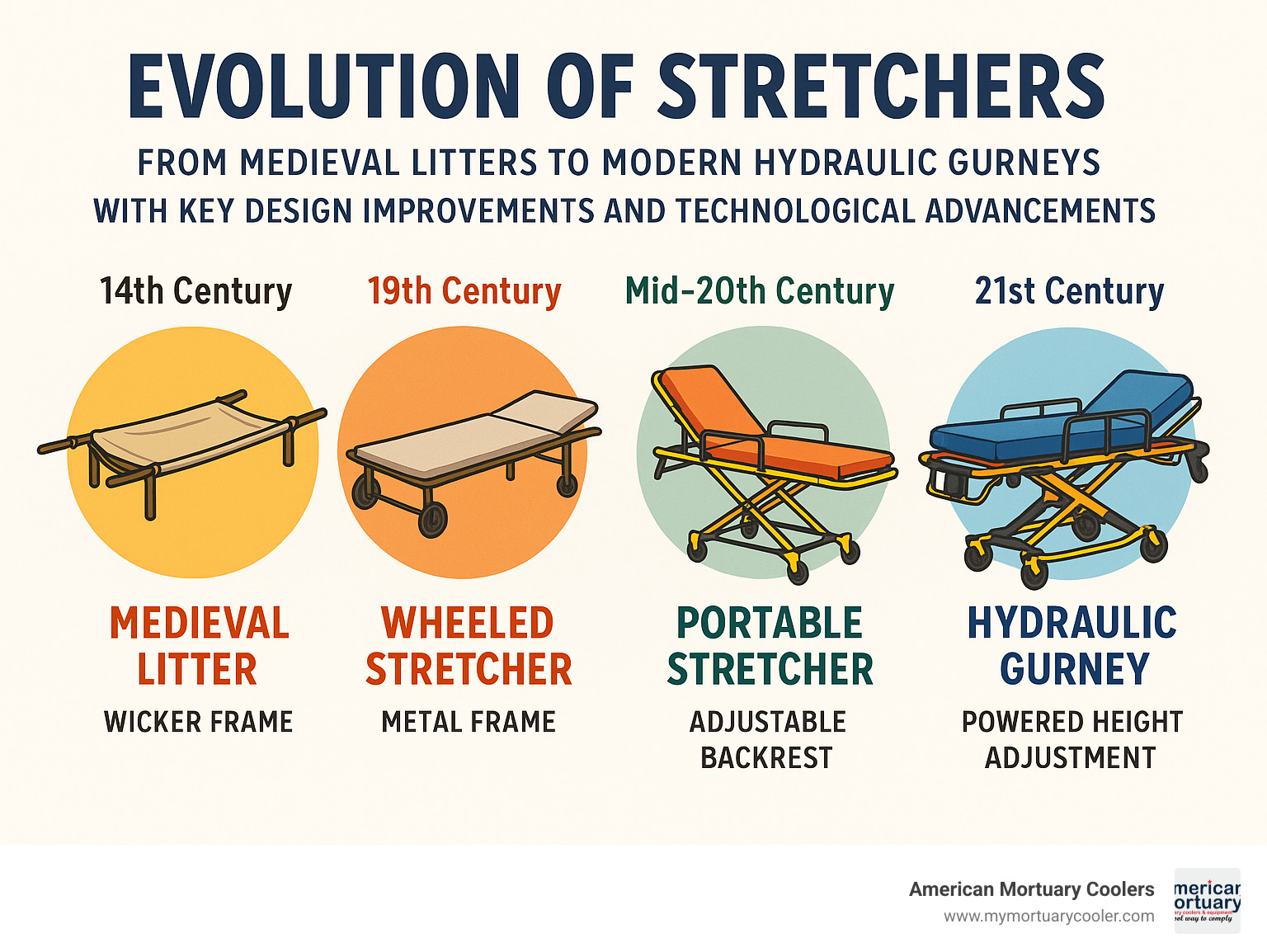
Stretcher stretcher terms to remember:
The Stretcher Story: Definition, History, Evolution
When you hear the term stretcher stretcher, you might wonder about the repetition – but this versatile device has earned its double-take name through centuries of lifesaving service. Whether you call it a stretcher, gurney, litter, or pram, these patient transport devices all serve the fundamental purpose of safely moving people who cannot walk or need to remain flat.
The word "gurney" has a fascinating origin story – it started as casual slang among medical workers on the Pacific Coast in the early 1900s before becoming standard hospital terminology by the 1930s. Meanwhile, "litter" traces back to military contexts, and "pram" remains common in European medical settings – showing how language evolves alongside the tools themselves.
Key Milestones in Stretcher Design
The journey of the stretcher stretcher is a testament to human ingenuity responding to practical needs:
The earliest documented stretcher appears in a medieval manuscript around 1380, showing a wounded knight being transported on a simple wicker frame. This basic design – two poles with fabric stretched between them – remained the standard for centuries.
The industrial revolution transformed stretcher production in the 19th century, bringing standardized manufacturing and a flurry of patents for improved designs. Suddenly, what had been handcrafted for millennia became mass-produced with consistent quality.
A particularly touching innovation came in the 1930s with the Thomas Stretcher, developed after a tragic incident where an injured climber had to be carried on a farm gate, ultimately resulting in a leg amputation. This collaboration between the Rucksack Club and the Fell & Rock Climbing Club of Britain shows how necessity drives invention.
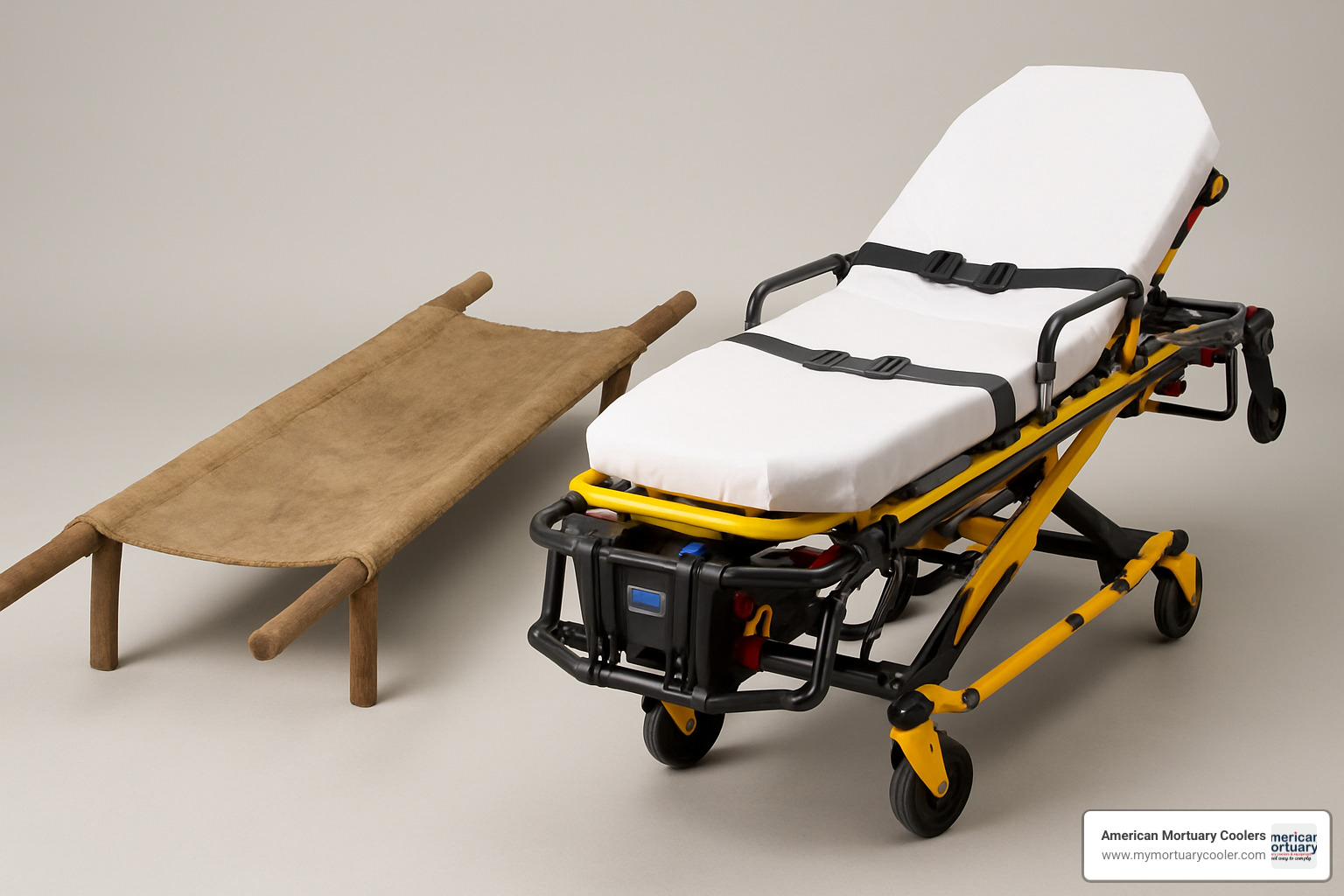
Mid-century innovations included specialized rescue equipment like the Neil Robertson stretcher, designed specifically for mountain rescue operations. By the late 20th century, hydraulic and pneumatic systems were reducing the physical burden on handlers.
Today's 21st-century stretcher stretchers feature battery-powered hydraulic systems that automatically raise and lower with the push of a button. These modern marvels aren't just about convenience – they're addressing a serious health crisis among emergency medical personnel.
The statistics on back injuries in EMS workers are truly alarming. According to scientific research, emergency medical workers suffer one of the highest rates of occupational back injuries of any profession, primarily from repeatedly lifting patients and equipment. The good news? Services that have adopted battery-powered hydraulic stretchers report up to 60% fewer lifting-related injuries – a remarkable improvement for these healthcare heroes.
From Battlefield to Hospital Hallway
The stretcher stretcher owes much of its evolution to military medicine, where battlefield necessity sparked rapid innovation. World War I saw standardized canvas stretchers that could be quickly folded and deployed, while World War II introduced lightweight aluminum frames that maintained strength while reducing burden on medics.
A powerful image from 1974 shows armed escorts carrying wounded across the Guinea-Bissau–Senegal border, highlighting how even in modern conflicts, the fundamental stretcher design remains invaluable for saving lives.
The late 20th century brought standardization to emergency medical services, including the familiar "antler" locking system that securely holds stretchers in place during ambulance transport. This small but crucial innovation prevents dangerous shifting during emergency driving, protecting both patients and providers.
From battlefield to hospital hallway, from mountain rescue to modern ambulance, the humble stretcher stretcher continues to evolve while maintaining its essential purpose – moving those who cannot move themselves with dignity, safety and care.
Core Stretcher Categories: Basic, Flexible, Wheeled, Specialty
When it comes to stretcher stretcher options, there's truly something for every situation. Let's explore the main categories you'll encounter, from the simplest designs to sophisticated specialty models.
Basic & Flexible Options
The humble pole stretcher represents the most fundamental design - just canvas or vinyl material stretched between two poles. These lightweight, budget-friendly options fold down for easy storage, making them perfect for disaster preparedness kits where you might need multiple units ready to go.
Folding canvas stretchers take this basic concept a step further with collapsible frames. Many hospitals keep these tucked away as backup units, ready to deploy during mass casualty events when every available resource matters.
The Reeves flexible stretcher wraps around patients like a protective cocoon, securing them with multiple straps. "These have been absolute lifesavers in tight spaces," shares one emergency responder. "When we needed to evacuate patients from a collapsed structure, the Reeves models let us maneuver through gaps where rigid stretchers simply wouldn't fit." Our catalog features several Reeves variants (models 101, 103, 105, and 106) each optimized for different rescue scenarios.
For wilderness rescues, the SKED sled design proves invaluable. These flexible units can be dragged over rough terrain, rocks, and even snow while keeping the patient securely immobilized. A mountain rescue team leader I spoke with put it perfectly: "When we're miles from the nearest road, the SKED is often our go-to. Its flexibility lets us steer tight spaces while maintaining patient security."
Wheeled & Hydraulic Systems
Modern ambulance stretchers feature variable-height capabilities through hydraulic or battery-powered systems. These engineering marvels make loading and unloading patients significantly easier, with specialized "antler locks" that secure the stretcher firmly inside the ambulance during transport. Additional features typically include adjustable backrest positions, IV poles, and oxygen tank holders - all designed to support patient care while in transit.
For larger patients, bariatric frames provide wider platforms and improved weight capacities, safely supporting individuals up to 700-1000 pounds. These specialized units help maintain dignity and safety for patients of all sizes.
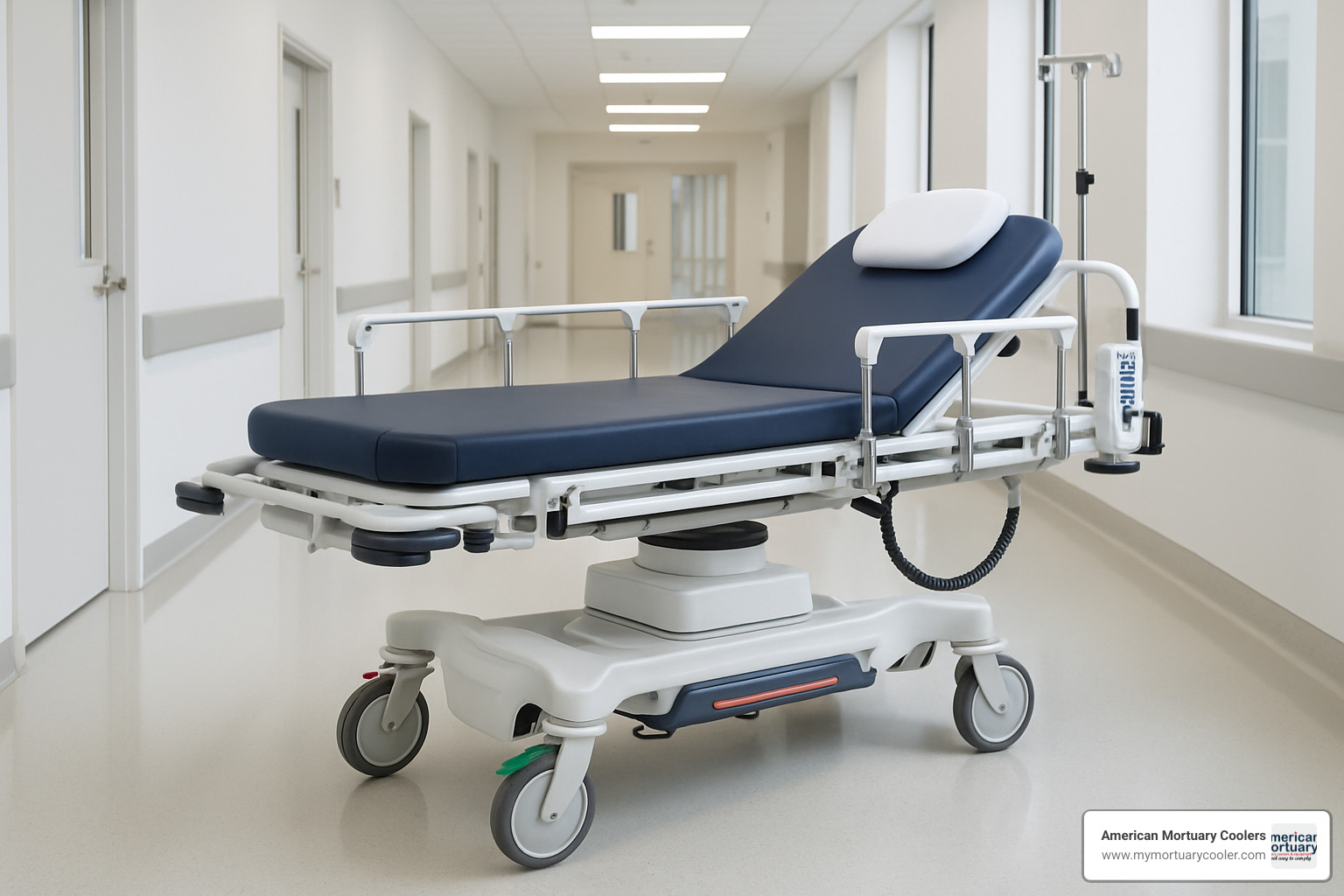
Within hospital walls, dedicated transport stretchers move patients between departments. These typically feature lower profiles than their ambulance counterparts and may include department-specific accessories like specialized imaging-compatible surfaces for radiology.
Specialty Units for Extreme Terrain & Confined Spaces
When rescues get technical, basket litters shine. These rigid frames with wire or plastic mesh fully contain the patient, making them ideal for vertical rescue operations where the person needs protection from multiple directional forces. Whether being hoisted up a cliff face or lowered from a helicopter, basket litters keep patients secure through complex maneuvers.
Navigating staircases presents unique challenges that standard stretchers can't handle. Enter the staircase chair, built with a right-angle configuration specifically for stair navigation. Our premium electric stair climber ($8,006.00) takes this concept further with motorized assistance that dramatically reduces strain on responders while improving patient safety.
The historical Thomas Stretcher featured wooden skis to glide over snow and rough terrain - an innovative solution that demonstrates how stretcher stretcher designs adapt to environmental challenges. Today's mountain rescue teams still use specialized sled attachments for winter evacuations.
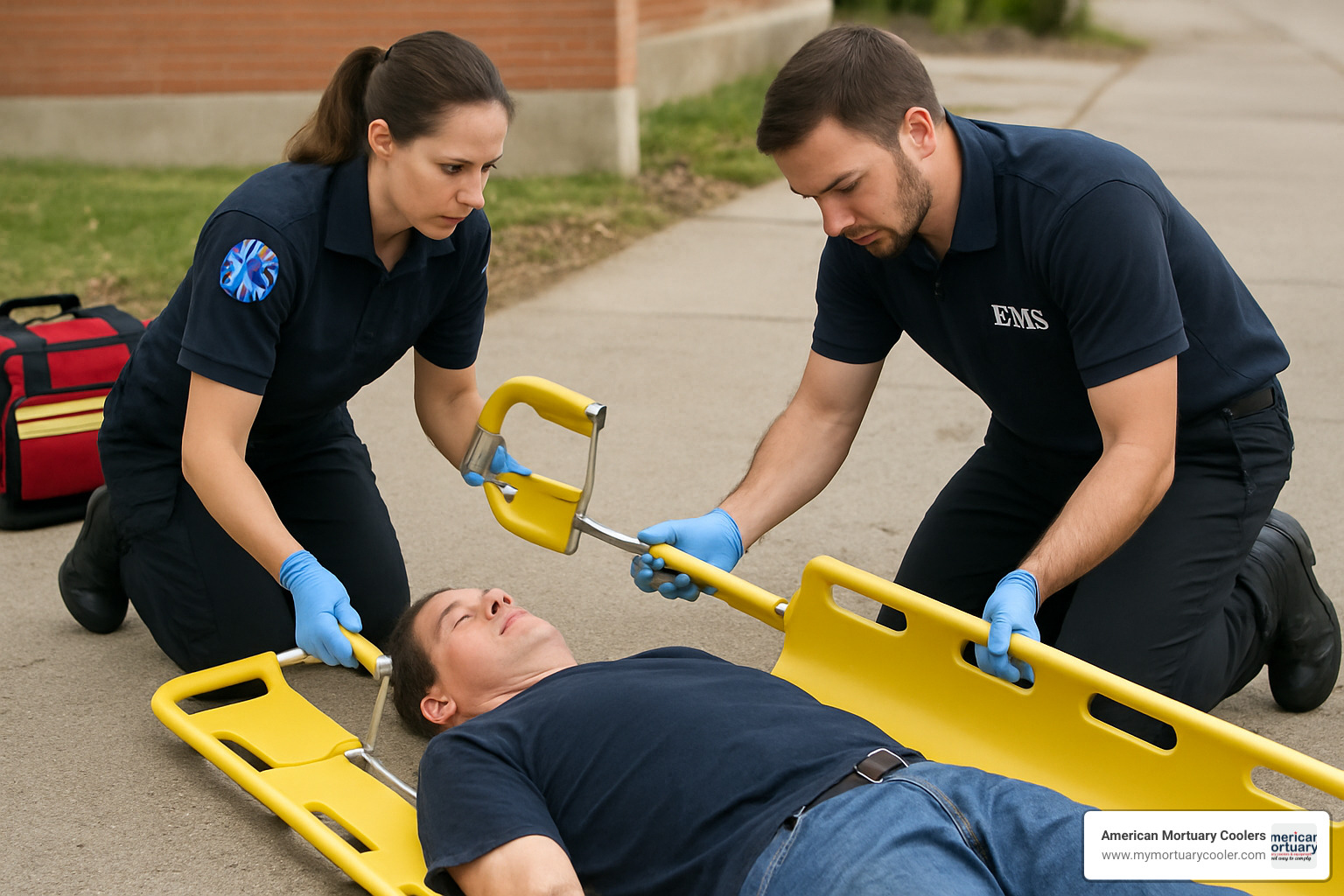
For suspected spinal injuries, scoop stretchers prove invaluable. These ingenious devices split lengthwise, allowing responders to place them around a patient without rolling them (which could worsen spinal damage). Once positioned, the halves lock together to form a rigid carrying device. This thoughtful design prioritizes patient safety during those critical first moments after an injury.
Selecting the Right Stretcher Stretcher: Features, Materials, Safety & Department Needs
Finding the perfect stretcher stretcher doesn't have to feel overwhelming. Think of it as matching the right tool to your specific needs—whether you're equipping a hospital department, emergency response team, or funeral home.
Weight Capacity and Materials
The materials used in modern stretchers directly impact their performance and durability. Aluminum stretchers offer that sweet spot of strength without excessive weight, making them perfect for teams that need portability. Steel models, while heavier, provide rock-solid durability and typically support higher weight capacities—a crucial factor when patient safety is on the line.
"We've seen a real evolution in stretcher materials," notes a veteran EMT with 20 years of experience. "Today's composite stretchers use advanced polymers that give you incredible strength without the weight penalty of traditional materials."
For art conservation, wooden stretchers remain the gold standard, offering the perfect balance of stability and adjustability for canvas works. Meanwhile, in medical and mortuary settings, weight capacity ranges dramatically—from standard models supporting 300-400 pounds to specialized bariatric units engineered to safely handle patients weighing up to 1,000 pounds.
Department-Specific Features
Walk through any hospital and you'll quickly notice that different departments have unique stretcher stretcher requirements:
Emergency departments need versatile units with rapid height adjustment and 360° mobility to steer crowded spaces. Operating rooms require precise positioning controls and surfaces that won't interfere with imaging. ICU stretchers come equipped with attachment points for monitors, IV poles, and specialized equipment.
The imaging department presents unique challenges—their stretchers must be constructed with radiolucent materials that won't show up on X-rays. Pediatric units feature smaller dimensions with specialized securing systems designed for smaller patients, while maternity departments use stretchers with specialized positioning capabilities.
At American Mortuary Coolers, we understand that funeral homes have entirely different requirements. Our mortuary stretchers focus on dignified handling, easy cleaning, and specialized features that respect both the deceased and support the important work of funeral professionals.
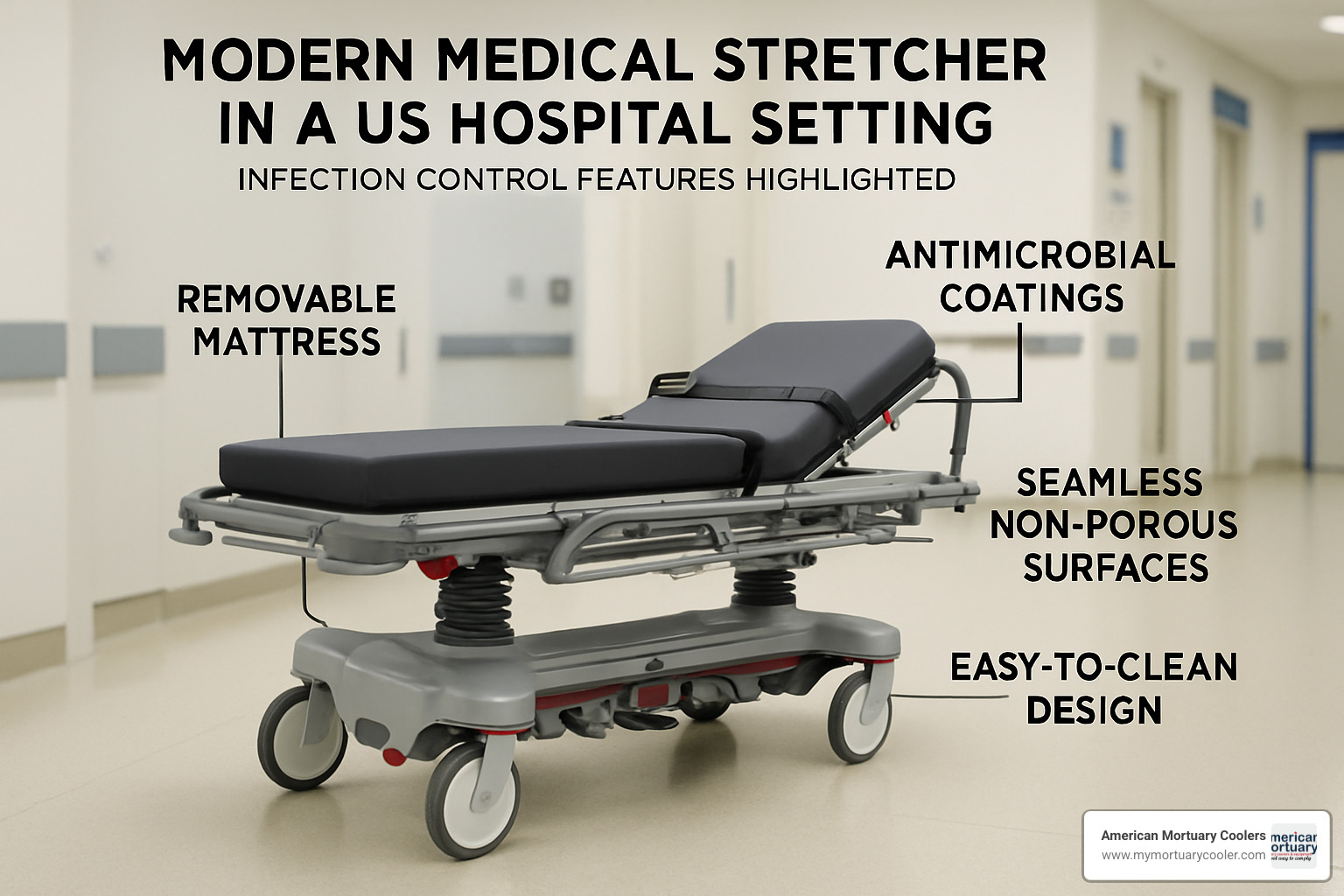
Safety Standards and Infection Control
Today's stretcher stretchers must meet rigorous safety standards—from OSHA requirements for handler safety to FDA regulations for medical devices. Infection control has become increasingly important, with modern designs featuring antimicrobial coatings, seamless construction to prevent fluid intrusion, and non-porous materials that resist bacterial growth.
"The pandemic really highlighted the importance of proper stretcher design for infection control," explains a hospital procurement director. "We now look for units with removable mattresses and surfaces that can withstand repeated disinfection without degrading."
These features aren't just nice-to-haves—they're essential protections for both patients and healthcare workers in challenging environments.
Stretcher Stretcher vs Transport Chair
Choosing between a stretcher stretcher and a transport chair often comes down to understanding your specific needs:
Stretchers excel when patients need to remain lying flat or have limited mobility, providing comprehensive support and multiple positioning options. They typically require two or more staff members to operate safely and need more storage space when not in use.
Transport chairs, by contrast, work wonderfully for patients who can sit upright and steer through tight spaces where a full-sized stretcher simply won't fit. They're lighter, more maneuverable, and often can be operated by a single caregiver—though they provide less overall support and positioning flexibility.
"I've worked in both large hospitals and small clinics," shares a patient transport specialist. "In tight hallways and older buildings, a good transport chair is worth its weight in gold—but you'll never replace the versatility of a proper stretcher for patients who truly need one."

Top Questions Before Buying a Stretcher Stretcher
Before making your investment in a stretcher stretcher, ask yourself these essential questions:
What's your realistic budget? The price range is vast—from under $100 for basic models to over $8,000 for specialized electric units with advanced features. Be honest about your specific needs—do you require bariatric capacity? Specialized positioning? Off-road capabilities?
Consider your storage situation carefully. Even the most amazing stretcher becomes a problem if you lack adequate space to store it properly. Think about the accessories you'll need daily—IV poles, oxygen tank holders, and restraint systems might be essential additions rather than optional extras.
Don't overlook warranty and service availability, especially for hydraulic and electric models. When a stretcher fails, you need prompt, reliable service. Finally, consider the cleaning protocols in your facility—some materials and designs make disinfection significantly easier than others.
For more detailed guidance on selecting the right medical stretcher for your specific needs, check out our quick start guide to the best medical stretchers or learn about the key differences between medical and mortuary stretchers.
Maintenance, Ergonomics, and Innovations from Healthcare to Art Conservation
The care and upkeep of a stretcher stretcher is as important as its design—whether you’re rolling down a hospital corridor, supporting a priceless canvas, or making sure every transfer is safe and smooth. Let’s explore how daily routines and new technology make a big difference, from healthcare to art conservation.
Medical Stretcher Maintenance
In hospitals, EMS, or mortuaries, a stretcher stretcher is only as reliable as its maintenance routine. To keep things safe and sanitary, regular cleaning is non-negotiable. After every use, high-level disinfection is a must—with special care given to creases, joints, and the nooks where germs love to hide. Always use disinfectants that protect both the patient and the stretcher’s materials.
Mechanical health is just as important. Wheels, locks, and any moving parts need regular attention—think lubrication, checking the lock mechanisms, and making sure hydraulic or electric systems work as they should. Don’t forget to inspect for cracks in the frame or loose bolts. If your stretcher stretcher won’t roll straight or won’t lock down, it’s not just an inconvenience—it’s a safety hazard.
Routine inspections help catch problems early. Verifying weight limits, checking the frame’s integrity, and making sure all safety features work correctly should be part of your scheduled checklist. A well-cared-for stretcher doesn’t just last longer; it protects both patients and staff.
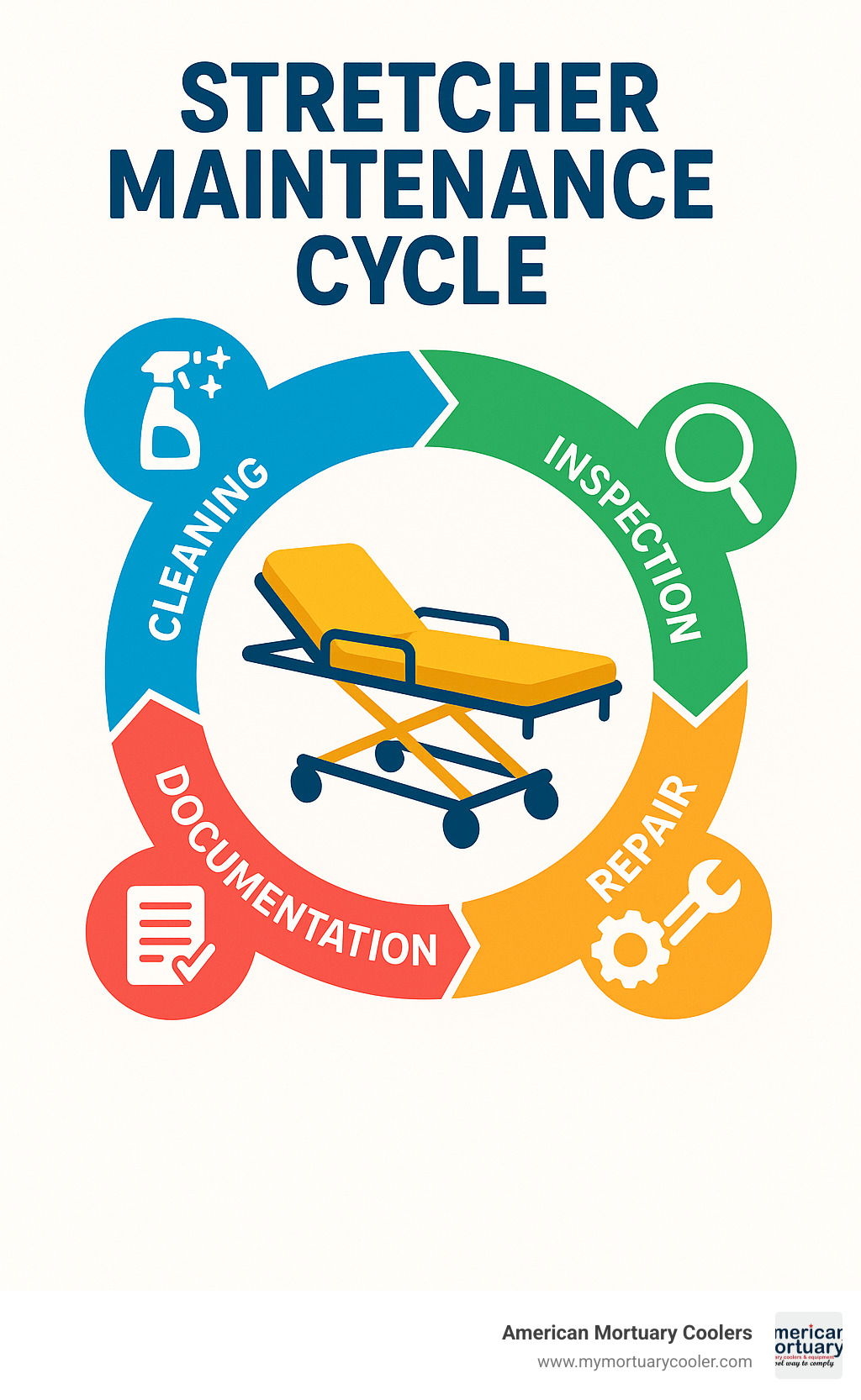
Art Conservation Stretchers
In art conservation, the stretcher stretcher takes on a different role. Here, it’s the unseen hero holding a canvas painting in perfect tension—sometimes for centuries! Maintenance might mean “keying out” the stretcher, a gentle process in which conservators tap little wooden keys into the corners to put the right tension back into a sagging canvas.
For larger paintings—those over about 30 to 36 inches—a cross-member is needed to keep the stretcher from bending or twisting. Traditional stretchers are often made from kiln-dried wood (to fight off warping), but modern versions can include aluminum, spring-tension frames, or clever expansion-bolt systems for precise adjustments. Aluminum Starofix stretchers, for example, can support massive paintings—up to 72×72 inches—without sagging.
Believe it or not, the stretcher itself might hold clues to an artwork’s past, from maker’s marks and gallery labels to the artist’s own scribbles. Conservation experts know that sometimes, preserving the original stretcher is just as important as protecting the painting it holds.
Safety & Ergonomic Best Practices
Whether you’re in a busy ER or rolling through quiet museum halls, safe handling of a stretcher stretcher is critical. Always use a proper lifting team—two people at minimum, but four is even better, especially for heavier loads. Everyone should coordinate their moves, lifting together to keep things balanced.
Modern innovations make life easier and safer. Battery-powered hydraulic lifts and motorized drives take much of the strain out of raising, lowering, or transporting even the heaviest patients. Proper strap placement and soft pads help keep patients comfortable and secure—particularly important for long transports or bariatric cases.
Staff safety is just as vital. Using the right body mechanics, wearing gloves for grip, and getting regular training all help reduce the risk of injury. There’s real science behind this: studies show that teams using battery-powered hydraulic stretchers have far fewer back injuries than those using older models. Investing in these updated systems isn’t just good sense—it saves money in the long run by keeping staff healthy and on the job. (See scientific research on EMS back injuries and stretcher ergonomics for more info).
When to Reuse, Modify, or Replace in Art Conservation
In conservation, decisions about a stretcher stretcher can get a bit philosophical. If possible, most conservators want to reuse the original stretcher—especially if it has historic importance. Sometimes, original stretchers come with a story: a maker’s stamp, a gallery label, maybe even a signature or doodle from the artist.
But what if the old stretcher is falling apart? Conservators must decide whether to reinforce it, replace it, or build a modern support that keeps the artwork safe for future generations. Here’s where the difference between a “strainer” (fixed corners, cannot expand) and a true “stretcher” (adjustable corners, can be keyed out) becomes important. For large or valuable works, a sturdy, adjustable stretcher is usually the best choice.
Sometimes, materials matter for appearance as well as function. A shiny metal stretcher might not suit a centuries-old painting, so conservators weigh the pros and cons carefully.
It’s amazing how many classic designs are still in use today—like the symmetrical raised-bead stretcher patented in 1882! History repeats itself for a reason: good ideas stand the test of time.
For more on art stretcher choices, see Stretchers and Strainers: Factors to Consider.
No matter the setting, routine maintenance, ergonomic best practices, and a dash of innovation keep every stretcher stretcher—from hospital workhorse to gallery treasure—ready for whatever comes next. And if you need expert advice or a custom solution, American Mortuary Coolers is here to help you roll safely into the future.
Conclusion
The world of stretcher stretcher products truly spans an impressive range - from the simplicity of basic pole designs to the sophistication of modern battery-powered systems, from emergency medical transport to the delicate work of fine art conservation. After exploring this fascinating landscape together, one thing becomes clear: understanding your specific needs is absolutely essential when selecting the right stretcher.
Here at American Mortuary Coolers, we've made it our mission to provide custom mortuary stretchers and related equipment specifically designed for funeral professionals. Our stretchers aren't just durable and easy to clean - they incorporate thoughtful features that enable dignified handling, addressing the unique challenges faced by mortuary professionals every day.
Whether you're running a family funeral home in Johnson City, Tennessee, or managing a large mortuary service in Los Angeles, our nationwide delivery ensures that quality equipment reaches you anywhere in the contiguous 48 states. We take genuine pride in crafting custom solutions that not only improve staff safety but improve the dignified care of the deceased - something we know matters deeply to you and the families you serve.
Looking for personalized guidance on selecting the perfect stretcher stretcher for your facility? Our friendly team is just a phone call away. We understand that each funeral home has its own unique requirements, and we're committed to providing equipment that meets those specific needs while maintaining the highest standards of quality.
Regardless of which stretcher type ultimately works best for your situation, three factors remain universally important: proper training for your staff, consistent maintenance of your equipment, and strict adherence to safety protocols. By investing wisely in quality equipment and thorough training, you ensure safe, dignified, and efficient transport for those in your care - which is what this profession is all about.
For more information about our full range of equipment options, we invite you to explore our detailed guide to Mobi Medical Supply Equipment.



